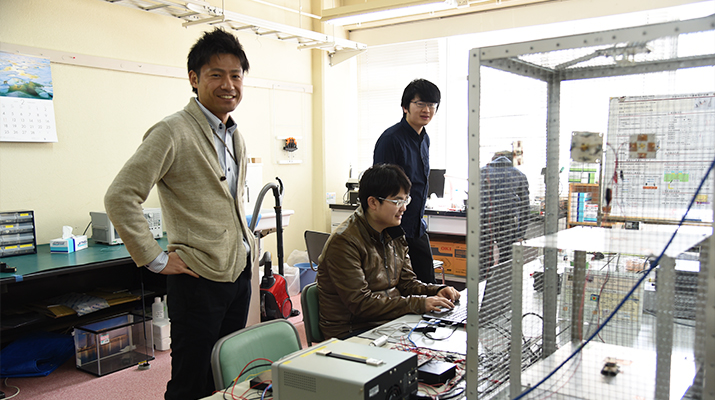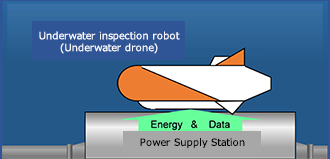
ここからコンテンツです。

Wireless power transfer in fresh water using capacitive coupling
Using underwater inspection robots to detect the early-stage deterioration of structuresBy Masaya Tamura
A research team led by Associate Professor Masaya Tamura of the Department of Electrical and Electronic Information Engineering at Toyohashi University of Technology successfully achieved wireless power transfer in fresh water using capacitive coupling. In the field of wireless power transfer, it had been considered difficult to realize wireless power transfer in fresh water using capacitive coupling because fresh water behaves as a dielectric material with extremely high dielectric loss. In this research, the team elucidated the high-frequency properties of fresh water through experiments. The team also discovered the frequency band that enables power transfer with high efficiency using an electric field and an electrode structure that can realize this high efficiency.
Wireless power transfer has attracted attention within a wide range of fields, ranging from mobile terminals to automobiles. Previously, research was mainly done in dry-land environments, though expectations are high for studies in underwater environments as the next target of research. For example, with regard to structural health monitoring systems for pipes, cooling towers or dam walls, there is an urgent need to develop underwater inspection robots that can move freely and perform inspection, even in the event of a disaster. Because these robots are battery-powered, with conventional technology it is necessary to pull them out of the water, charge them, and have them dive back into the water repeatedly. The development of technology to transfer power and information wirelessly in water, therefore, (Figure1) will be key in improving the efficiency of this work.

As a solution, the research team led by Associate Professor Masaya Tamura developed a capacitive coupler that can supply power wirelessly in fresh water with high efficiency.
The efficiency of wireless power transfer depends on the kQ product, which is the product of the coupling coefficient k of the coupler and the Q-factor of the coupler loss including the influence of the surrounding environment. The higher the kQ product, the better the transfer efficiency. Since the influence of water surrounding the coupler is dominant over the coupler itself in an underwater environment, the study focused on the high-frequency properties of fresh water. The team made its own cell for measurements and clarified the relationship between frequency and the Q-factor of fresh water.

Based on these results, the team used electromagnetic field analysis to find the frequency of power transfer and the structure of the coupler where the value of the kQ product in fresh water is at a maximum. The team achieved a power transfer efficiency of at least 90% at a transfer distance of 2cm and at least 80% at 5cm. The team also succeeded in activating a sensor module via wireless power transfer to conduct infrared data communication. Power transfer efficiency was maintained at 90% or higher over a distance of 2cm, even when transferring 400W of power. Considering that the robot will park on top of the power supply station, this technology is suitable for practical use.

The result of this study will allow for robots that inspect the pipes and cooling towers of power plants or dam walls to communicate information and charge their batteries within the areas of inspection. The research team believes the technology will contribute to drastic improvements in user safety as well as in the operational efficiency of the robots. The coupler newly developed by the team is simple and lightweight, and therefore the impact on the total weight of the underwater inspection robot is kept to a minimum. Use of this lightweight coupler can also eliminate the need for an extensive redesign of the buoyancy system. The team seek to soon achieve the communication of information with electric field coupling in fresh water, as well as highly efficient wireless power transfer in seawater. Their ultimate goal is to realize the wireless transfer of power and information transfer in both fresh water and sea water.
This research was supported by REFEC: Research Foundation for the Electrotechnology of Chubu and Japan Society for the Promotion of Science, Grant-in-Aid for Scientific Research (C)
Reference
- Masaya Tamura, Yasumasa Naka, Kousuke Murai, Takuma Nakata (2018). Design of a Capacitive Wireless Power Transfer System for Operation in Fresh water, IEEE Trans. Microwave Theory and Techniques, vol. 66, no. 12, pp.5873-5884, Dec. 2018.
https://ieeexplore.ieee.org/document/8516348 - Yasumasa Naka, Kyohei Yamamoto, Takuma Nakata, Masaya Tamura (2017). Improvement in Efficiency of Underwater Wireless Power Transfer with Electric Coupling, IEICE Trans. Electron, vol. E100-C, no. 10, pp.850-857, Oct. 2017.
http://search.ieice.org/bin/summary.php?id=e100-c_10_850
電界結合で水中無線電力伝送を実現
水中点検ロボットで構造物の劣化をいち早くキャッチBy 田村 昌也
豊橋技術科学大学 電気・電子情報工学系 田村昌也准教授らの研究チームが、電界結合を用いて淡水中での無線電力伝送に成功しました。無線電力伝送の世界では、淡水は非常に損失の大きな誘電体としてふるまうため、電界結合による水中での無線電力伝送は困難だとされてきました。今回、淡水の高周波特性を実験により明らかにし、電界でも高効率に伝送可能な周波数帯と高効率化を実現する電極構造を発見しました。
無線電力伝送はモバイル端末から自動車まで幅広い分野で注目を浴びています。これまでは陸上環境での研究が主でしたが、次のターゲットとして水中環境が期待されています。例えば、配管や冷却塔、ダムの堤体壁面など構造ヘルスモニタリングシステムにおいては、自由に移動でき、災害時でも調査が可能な水中点検ロボットの開発が急務となっています。このロボットはバッテリ駆動のため、充電のために何度も引き上げ、再び潜航させるという作業を繰り返す必要があります。このような作業による運用効率の低下を改善するには、給電ステーションを介した水中での無線電力情報伝送(図1)の技術開発がキーとなります。
そこで、田村昌也准教授らの研究チームは淡水中でも高効率に無線で給電できる電界結合器を開発しました。無線電力伝送における電力伝送効率は伝送用結合器のもつ結合係数kと周辺環境の影響も含めた結合器の損失を表すQ値の積であるkQ積に依存します。kQ積が高いほど伝送効率も向上します。水中では結合器よりも結合器を取り巻く水の影響が支配的であることから本研究では淡水の高周波特性に注目し、自作の測定セルを用いて測定を行い、周波数と淡水のQ値の関係を明らかにしました。
その結果を用いて電磁界解析から淡水中でkQ積が最大値を示す電力伝送周波数と結合器構造を明らかにしました。これにより送電距離2cmで90%以上、5cmで80%以上の電力伝送効率を実現しました。実際に淡水を介した無線電力伝送でセンサモジュールを駆動し、赤外線によるデータ通信にも成功しました。また、400Wの電力を送電距離2cmで送電しても電力伝送効率90%以上を維持できています。給電ステーションに着底することを考えると、実用に耐えうる効率と考えられます。
研究チームは、本研究成果により発電所の配管や冷却塔、ダムの堤体壁などの水中点検ロボットに対し、点検区域内での通信・充電が可能となり、使用者の安全性やロボットの運用効率の飛躍的向上に貢献できると考えています。開発した結合器は非常にシンプルかつ、軽量であるため、水中点検ロボットの総重量に与える影響を最小限に抑え、浮力システムの大掛かりな再設計も不要になることが期待されます。また、電界結合による淡水中での情報通信や海水中での無線電力伝送効率も高効率化が見えてきており、最終的には、淡水・海水のどちらでも無線電力情報伝送を実現したいと考えています。
Researcher Profile

| Name | Masaya Tamura |
|---|---|
| Affiliation | Department of Electrical and Electronic Information Engineering |
| Title | Associate Professor |
| Fields of Research | Wireless power transfer / Microwave circuits / High frequency circuit |
ここでコンテンツ終わりです。
